 |
|
|
|||||||||||
|
Engine change
Step 1 Step 2 Removal of an old Mercedes 636. Notice we have the floor and deck covered to protect the woodwork.
Step 4 Step 5
Notice everyone is starting to smile.
Scott always keeps a bottle of cleaner handy! Have a question about how to buy a boat cheap? How to make
money with boats? How to get a job on a yacht? Marine career counseling
question? How to maintain your metal boat? Corrosion issues? Engine
change? Electrical issue? Engine won't start? Recommend a new cruising
system? Trouble shoot a difficult fault? Business Idea you want run
by someone? Why not ask Yachtwork. For a small fee I will give you a personal answer to any topic I'm qualified to help with. Sign in to the Justanswer box above and ask away. All answers responded to in less than 24 hrs, and most within two hours. Special considerations
And the boat is ready to go back into the water. This was the process of enlarging the exhaust system and enlarging the prop. The old aqua lift built into the keel had to be opened and a new cover plate with the new SS tube installed. The old 2" through-hull was removed and a new 3" put in it's place. Much of this through-hull work was done expertly by Jason on Baggywrinkles.
Commonly asked questionsQuestion - What is this all going to cost? The cost of the whole package varies wildly depending on Yacht location, equipment available to help with the change, and how much the owner wants to do himself. With all those varables we can start the pricing. The cost of the installation process normally runs about $400 to remove the old engine. $600 to build the new rails, place the new engine in place and align. The hooking up of all the extras is in the $750 range. This tends to be a total package of about $1700-$2500 in labor to change an engine. If the owner decides to add a dual alternator at this time they can normally save about $200 as we will have all our tools on hand. I must stress these prices are all general. Everything is time and materials. If the yacht was built with difficult access that takes more time and thus more money. The prices given above are general, but realistic. Question - I have a Perkins 4-108 and I want to change it with the Yanmar 56hp. Are there any special considerations to think about?
Question - Can I do some of my own work? Sure, you can do any and all work. Scott works by the hour. You can have just a consultation where Scott can give you a detailed explanation of how to do your own work. Many cruisers are comfortable with much of there own mechanic work, but the thought of a complete engine change seems daunting. For that you could have Scott help with the consultation, remove the old engine, build the new rails, then align and bolt down the new engine. Then the owner can continue with hooking up the water, power, diesel, etc. We have helped install engines by just consulting and the owner took over. Other owners have had us change their engine by just communicating with us by email while they were in the states. The biggest single savings the owner can do on an engine change is the installing of the new instrument panel. This can take hours and needs lots of thought by the person who is going to be at the helm. This is a common area of savings for the owner.
Ten days would be long engine change. It all depends on whether more than a normal engine change is needed. Some things that can cause delays are the prop shop sending the wrong prop. Parts stuck in customs. Money transfers stuck in international banks. Most of these types of difficulties don't cost much money, just time. Things that cost money are the rare situations where the engine beds need to be cut down, or even more rare we find structural problems in the vessel itself. Also the one week engine change is for the basic engine change. Many times the owner wants to use the special access to the bilge to change all the bilge pumps, hoses, and wiring. This all adds to the total time, but this is normally planned out in advance. Question - Does the boat have to be hauled for an engine change? No, definitely not. In fact having the boat hauled makes the engine change more difficult. We need a very calm anchorage or dock and electrical power. Most modern yachts have an inverter and battery bank that will hold through the project. The boats used in these examples had special reasons to haul. For example one wanted to do a bottom paint and combine both projects to keep the number of down days to a minimum. The other was upping the horse power and thus needed a bigger prop. Question - You mention Yanmar often. Do you install other engines also? Yes, we install whatever engine or generator the owner chooses. We do tend to replace most power packs with Yanmar as they dominate the 12-100hp yacht engine market and I feel they are the best yacht engine made. Isuzu, Kabota and Perkins are also available but they don't tend to have all the options available. The other consideration is Yanmar is often an off the shelf item. You can walk into the Yanmar dealer and choose your engine on the day you want it. If they have to order they can have the engine in as little as four days.
|
||||||||||
| © Team Yachtwork 2007 | |||||||||||
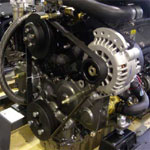
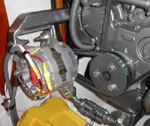
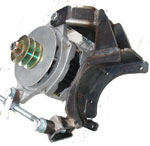
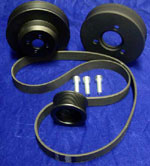

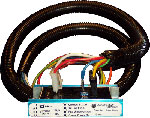
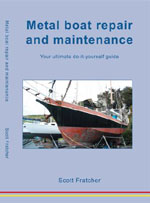

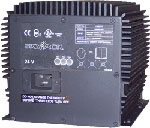

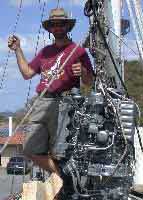 We
have perfected the one week mobile yacht engine change. Below are some
examples of our system and work.
We
have perfected the one week mobile yacht engine change. Below are some
examples of our system and work.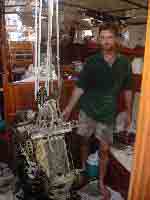



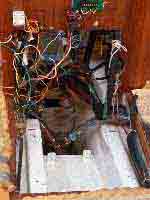
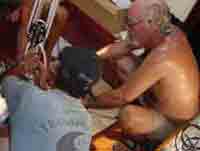 Step 3
Step 3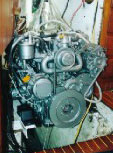
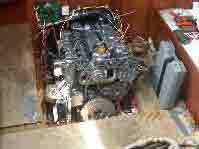
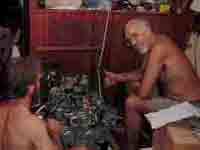 Step
6
Step
6 Step
7
Step
7 Sometimes
engine changes can have special circumstances. For example if the vessel
had 40hp engine and the owner wanted to replace it with a Yanmar 75hp
then the exhaust system may need to be enlarged. In the examples below
you see a Perkins 4-108 being replaced with a Yanmar 75 hp and a 2"
exhaust being enlarged to a 3". The prop was also changed from
an 18" to a 22". This vessel, a Passport 40 achieved 7+ knots
from a dead stop in about 8 seconds. Amazingly we changed another engine
in a Passport that same season and only installed a 56hp in that vessel.
Both had the same top speed, but the 56hp took almost twice as long
to reach 7+ knots. For the vessel in a seaway that should mean the ability
to motor into a heavy head sea with more punch.
Sometimes
engine changes can have special circumstances. For example if the vessel
had 40hp engine and the owner wanted to replace it with a Yanmar 75hp
then the exhaust system may need to be enlarged. In the examples below
you see a Perkins 4-108 being replaced with a Yanmar 75 hp and a 2"
exhaust being enlarged to a 3". The prop was also changed from
an 18" to a 22". This vessel, a Passport 40 achieved 7+ knots
from a dead stop in about 8 seconds. Amazingly we changed another engine
in a Passport that same season and only installed a 56hp in that vessel.
Both had the same top speed, but the 56hp took almost twice as long
to reach 7+ knots. For the vessel in a seaway that should mean the ability
to motor into a heavy head sea with more punch.

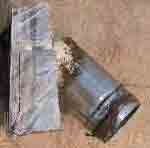
 This
is a very common engine swap. There are two added difficulties. First
the exhaust comes out on the port side of the Yanmar and the Starboard
side on the Perkins. Sometimes the exhaust hose will just swing over,
other times we have to make up a double 45 to reach the old aqua lift.
This sounds much more difficult than it tends to be. The second challenge
is the Yanmar has reverse throttle action on the injection pump. Push
becomes pull, or however you move your throttle control right now will
be reversed. The owner can choose to get used to his new throttle linkage,
or Scott can build a throttle reversing mechanism. This can not be taken
lightly. Engine control systems must be 100% dependable. If the throttle
linkage were to fail during docking it could cause an expensive situation.
For this we take our time and over build all shifting/throttle linkages.
Notice below we used 1/4" plate on the system.
This
is a very common engine swap. There are two added difficulties. First
the exhaust comes out on the port side of the Yanmar and the Starboard
side on the Perkins. Sometimes the exhaust hose will just swing over,
other times we have to make up a double 45 to reach the old aqua lift.
This sounds much more difficult than it tends to be. The second challenge
is the Yanmar has reverse throttle action on the injection pump. Push
becomes pull, or however you move your throttle control right now will
be reversed. The owner can choose to get used to his new throttle linkage,
or Scott can build a throttle reversing mechanism. This can not be taken
lightly. Engine control systems must be 100% dependable. If the throttle
linkage were to fail during docking it could cause an expensive situation.
For this we take our time and over build all shifting/throttle linkages.
Notice below we used 1/4" plate on the system. Question
- Does an engine change ever take longer than ten days?
Question
- Does an engine change ever take longer than ten days?